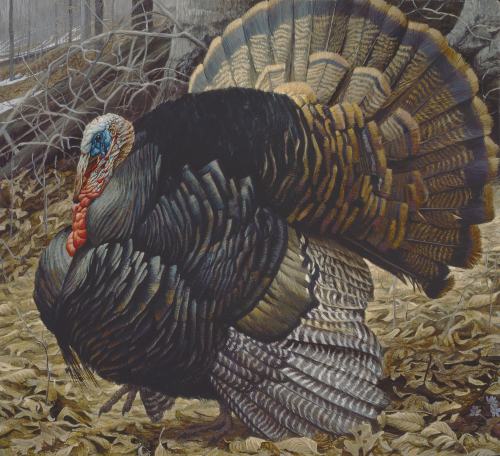North in the Spring # 22:
Turkey Talk by John Neville in BC Nature magazine winter issue.
A turkey is a central feature at Thanksgiving and various winter holidays such as Solstice, Christmas and New year. Properly cooked the bird is not only tasty, but pound for pound more economical than other proteins. We usually have one in the freezer any time of year and our local farmer provides us a fresh one for Christmas. This year we were on the "Canadian" for Thanksgiving, riding the rails through the boreal forest with the changing colours of the Sugar Maple and Tamarack trees. We gave thanks for a delicious turkey dinner that we got to share with two members of Nature Vancouver. How did the turkey evolve into such an important feature in our society?
 A secondary part of the feast is the "stuffing". This is a tasty mixture of breadcrumbs , herbs, spices, nuts and choice flavours to fill the large abdominal cavity when the bird is oven ready. The stuffing is often presented as a separate item on the menu. When the Spanish first arrived in the New world, First Nations were hunting Wild Turkeys in the forest. There are six subspecies , the Mexican variation being the most colourful and still found in the Yucatan today called the Oscellated Turkey. For example the tail feathers of the male and female are bluish-green, with an eye-shaped bronze spot near the end with a bright gold tip. Most subspecies are a various shade of brown, standing over a meter tall with strong legs for running. They can fly up to 60 km/hr for short distances. In 1510 King Ferdinand of Spain first enjoyed a tasty turkey dinner. They were so popular that one year later the King ordered all his returning ships to include five male and five female birds in their cargo. The European diet was greatly improved by the arrival of the turkeys, potatoes, pumpkins, various squash plants, tomatoes, corn(maize) and beans. It was only a few years later that the Pope and HenryV111 also ate their first turkeys. Ships returning from the new world sometimes traded in the eastern Mediterranean before returning to western Europe. This may have been why the bird became known as a Turkey? The birds were quickly domesticated and the Pilgrim Fathers brought some of them back to North America. However, the pilgrims were soon introduced to wild turkeys in the forest by the First Nations. Today turkey is an important part of our diet. If treated with care they are quite easy to breed in captivity for the domestic market. It was estimated in 2012 that global turkey production reached 5.6 million metric tons. However wild turkeys are also very popular and their siting and sounds are wonderful in a wilderness setting! In the last century some were introduced onto Vancouver Island with limited success. About 40 years ago introductions took place in Northern Idaho. These birds were very successful and quickly expanded their range across the international border into Creston and beyond. Signs were quickly made "Beware Turkey Crossing" on Hwy3. I can remember walking behind a flock trying to record them along the shoulder of the highway. It was not until several years later that I was able to make a good recording in the Frenchman River Valley Saskatchewan. Apart from the pleasure of hearing them in the wild, I became very aware of one of their characteristics: when behind fences, they appear like dumb critters but in the wild they are very wily and canny about their enemies. Last year 100 of the wild birds were seen walking down the main street of Edgewater! A complainant in Castelgar was concerned that a flock of 50 in his subdivision were eating everything in his yard, stopping traffic and one went through a lounge window. There is now a hunting season in the Okanagan and Kootenays for these delicious birds. To everyone around the province, Merry Christmas. |